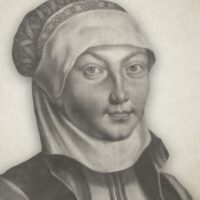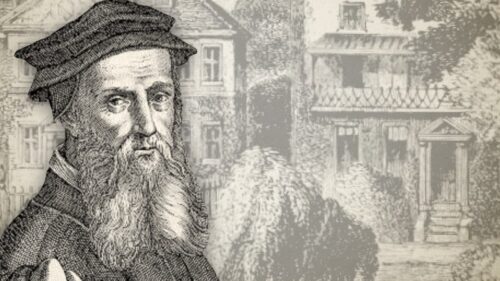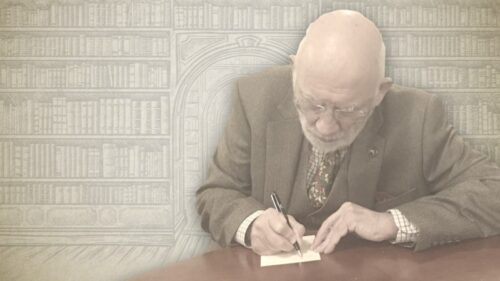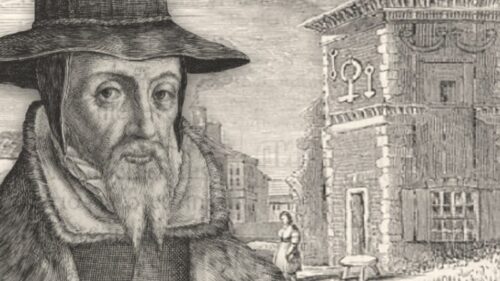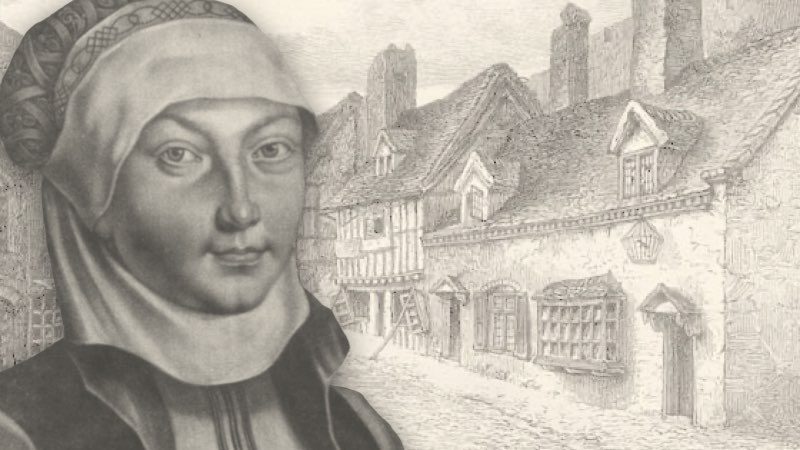
Katharina Luther (1499-1552): The Morning Star Of Wittenberg
[Posted With Permission, Peter Meney Of “New Focus“]
MY LORD KATIE
They say that behind every successful man there is a woman; the point being that the man would have been less a man without his wife. This piece of earthly wisdom is rarely applied to Martin Luther. The German Reformer is invariably depicted as “The Monk Who Changed the World”; the idea being that ingredients of Reform are to be found in cloistered, celibate seclusion. Such a conception might suit Rome but it is foreign to Biblical thinking. The alarming fact is that Luther’s critics, of whatever category, often appear to be blissfully unaware that Luther did his best work as a happily married man. Nick-names often reveal traces of character hidden by lexical nomenclature. Any student of Luther needs to notice how he addressed his wife and sweetheart, Katharina von Bora. His pet and public name for her from his wedding speech to his dying days, was “Mein Herr Käthe”, i.e. “My Lord Katie”. To one familiar with the German language, this appellation shows that Luther not only felt Katie’s affection strongly, but also her influence.
Martin’s and Katie’s contemporaries always referred to the couple in one breath as ‘Luther and Lutheress’ (Germ. Lutherin), emphasizing their joint importance. Luther made sure that Katie should be accepted as his equal in all ways. Contrary to the legal custom of the day, he insisted on making Katie his heir and legatee, even if she should remarry after his death. Luther also made Katie his children’s legal guardian, contrary to contemporary practice. When Luther died, his enemies believed Katie, whom they called Doctorissa, would continue her husband’s work. They thus used all their energies to rob her of her property, reputation and influence. Paradoxically, today, Katie is ignored by most friends of Luther but respected by his foes.
The closeness of Martin and Katie Luther in their work of reformation is shown by their portraits. The wives of most Reformers were never portrayed. Not only are there numerous paintings and drawings of Katie, but artistic eye-witnesses of the Reformation such as Lukas Cranach, invariable painted Luther and Katie together. Four of such double Cranach paintings are extant but they are usually shown nowadays as if Luther were divorced physically from his wife. What God so obviously united, are separated in a faulty display of honour to Martin and to the detriment of Katie. One can peruse through book after book on Luther and find him looking serenely out in space, when actually his eye is on his beloved Katie who has been rudely removed. This essay is an attempt to put Katie back in her rightful place at the side of her husband.
A CHILDHOOD SLAVE
Katharina von Bora was born on 29 January, 1499, the child of landed gentry who were selling off one plot of land after another to keep out of debtors’ prison. By the time Katie was five years of age, her father, Hans von Bora, had lost his fight with debt and placed her in the care of the ‘Church’. She was now regarded as papist property and trained as a nun. At the early age of sixteen, Katie was moved to Marienthron Nunnery near Grimma and forced to take an oath of poverty, chastity and obedience to the papist system. Marienthron (Mary’s Throne) was famous in those days. The nunnery boasted 367 saintly relics from toe nails to spare ribs, each set in gold, rock-crystal and precious stones. Marienthron’s most precious possessions were splinters hacked from Christ’s cross and hairs pulled from the Virgin’s head. Apart from this wealth of cemetery dust, the nunnery had a large farm which was worked at a great profit as the young girls were never paid. Here, Katie spent her days, working hard in the fields and praying numerous ave marias before the above mentioned hairs, rotting wood and bones. In God’s good providence, according to the burial formula ‘ashes to ashes’, Marienthron is now also a mere heap of dust. No longer can the cloister dupe poor pilgrims into feeling they are nearer heaven after peeping into a charnel-house, symbolic of their faith.
Happily, Katie had an aunt at the nunnery, Magdalena von Bora, who took care of her niece, preserving her from the more evil perversions of nunnery life. Magdalena was to join Katie at Wittenburg when the Reformation released them from their slavery. That release soon came. After 1517, a great change came over many parts of Germany. Luther not only protested successfully against the financial corruption of Rome and her spiritual poverty but also pointed priests, monks and nuns to a healthier view of family life. By 1521, the celibate sanctuaries were being emptied as men and women found a blessed life in Christ which the pope could not give them. Most of these former vestal slaves felt they should honour God by entering into wedlock and raising a godly family. By 1522, this movement had reached Grimma. Two men professed Christ in the town and immediately thought of their sisters locked up in the nunnery. Luther, though still unwed, had written a work entitled Married Life, so the two brothers had it printed and distributed in Grimma.
REFORMATION MARRIAGES
Soon Luther’s work was smuggled into Katie’s cloister and was read clandestinely by the forty-three nuns, all of noble families. At this time, the monks fleeing from Rome’s thraldom far outnumbered the nuns who were kept under severe and constant surveillance. However, one dark night in 1523, a rope was thrown from a small window in Marienthron and twelve ladies, who now saw the difference between married to Christ and enslaved to the pope, climbed down to freedom. One of them was Katie. It was a smelly freedom at first. The ladies’ only male ally was Leonard Koppe the fishmonger. He had arranged to transport the female aristocrats via Torgau to Wittenberg, the centre of Germany’s Reformation, camouflaged under fresh fish in barrels. Awaiting the ex-nuns was a scene to delight the heart of any Marriage Guidance Council. Each choice maiden, freshly divorced from Rome, was to be married, voluntarily, mark you, to a Protestant gentleman. Twelve prominent bachelors, denied female company too long by the nunneries, were lined up to meet their unknown brides. One by one, the ladies actually found the men to their liking. All, that is, except young Katie. She was introduced to a sixty-year-old pastor. One look at him compelled Katie to say ‘No’.
Then Katie spoke boldly, “I shall have either Nikolaus von Amsdorf or Martin Luther himself. If neither of these is available, I shall remain, so God will, single.” Von Amsdorf made the choice easy. He had no intention to marry and indeed, he remained a bachelor all his days. All eyes were now on Luther who, for once, was speechless. He had thought a good deal about marrying off all his friends but had not considered his own conjugal needs. Katie moved in with Mr and Mrs Lukas Cranach until Luther made up his mind.
LUTHER GAINS HIS LUTHERESS
The reasons why Luther thought he could not marry were sound. He was loath to ask a wife to join his family in their present state. His father had never forgiven him for becoming a monk in 1505 and Luther believed that reconciliation with his parents should go before marriage. Luther felt he could not start a family as the task of Reformation still lay to a great part before him and he was at everybody’s beck and call at that time and had no time for a private life. Furthermore, the Peasant’s War was on in full force and many on both sides of the controversy were demanding Luther’s head. As far as Rome was concerned, Luther was wanted dead rather than alive. Luther did not want to marry today and leave a widow tomorrow. Nor had, Luther a penny to call his own and no home to which he could invite a wife. To complicate matters more, several of his Reformed friends had still one foot in Rome and believed in the celibacy of the clergy. One of these was Phillipp Melanchthon who wrote to Luther warning him against entering into wedlock. He felt that it would be denying one’s calling in Christ.
By 1525, all these problems were resolved and Luther felt it was God’s will to marry Katie who had already formerly proposed to him. Luther was now forty-two years of age and Katie twenty-six. The marriage took place in private on June 13 and Melanchthon was not invited. Koppe, the fishmonger, however, had a place of honour at the marriage feast. None came from Katie’s family as all had died. Luther could not afford a wedding ring but the King of Denmark had given Katie a simple golden bangle which she now re-fashioned for the wedding ceremony. Katie’s first home as a married woman was a monastery called the Black Cloister. The building was begun before the Reformation and now stood half-finished and already in ruins. Katie quickly turned the derelict rooms into a home and made her husband rid himself of many of his bachelor ways. His bed, for instance, had been an old sack full of dirty straw and he had neglected both hygiene and health. Luther had also no conception of living a planned life according to a budget and was totally naïve in financial matters. Katie had often to hide necessary household utensils, otherwise Martin would have given them away.
Sadly, popish superstition still flourished in Reformed circles. It was said that when Antichrist came, he would be the offspring of a monk and a nun. Thus the story was spread that Katie and Martin had only married to ‘legalise’ the advent of Antichrist conceived before that marriage. This belief had to be dropped as Katie gave birth to her first child, a son, on 7 July, 1526 over a year after being wed. Elizabeth followed Johannes in 1528; Magdalena in 1529; Martin in 1531: Paul in 1533 and Margarethe in 1534. Elizabeth died aged ten months: Magdalena aged twelve years. Both Katie and Martin loved children and besides their own, they housed no less than eleven orphaned or otherwise homeless children who were treated as members of the family.
FAMILY LIFE IN WITTENBERG
Luther had received no wages as a Professor owing to his being a monk and had had no regular income as a preacher. He had no interest in worldly goods whatsoever. Katie resolved to change things. She started on their wedding day. Katie noted that those bringing wedding presents to Luther were told to keep their gifts, so she met their guests on the doorstep and accepted the gifts in the name of herself and husband before Martin knew anything about it. The records show that before marriage Luther’s entire fortune was around 20 Gulders. Immediately after marriage, he was earning 200 Gulders a year. Katie, was most sensible in such matters and when gifts came in that were not needed, she, too, would refuse them or re-channel them. At Katie’s initiative, a large vegetable garden was cultivated behind the cloister, which provided a good deal of food for the Luthers and helped them save money. Here, Katie’s experience on the Marienthron farm came into good use and soon she had also cows to milk, poultry to keep, malt to make and a brewery to run. Luther was meanwhile writing book after book but also refusing to be paid for his work. Many critics did not notice Katie’s industry but only the prosperity that it gained and spread rumours that the Luthers were making money out of the Reformation. Sensible people called Katie ‘The Morning Star of Wittenberg’ as she was always up early working on the farm and going about her calling. In 1532, Elector John, decided to give the Luthers the cloister and farm land, obviously thinking it was worthless. Jealous criticism spread, however, when less industrious people saw how well Katie managed the property. Martin was very sensitive of this criticism and begged Katie to consider a smaller house, but she refused. Luther came to respect his wife’s judgement as he was about to set up a training college for ministers and the financing of a separate building would have been immense. Now the empty rooms in the cloister were turned into student quarters.
ONE CALLING, TWO ADMINISTRATIONS
Martin had begun to address a group of Reformers regularly in his study and it is from these pastoral conversations that his famous Table Talks arose. The men never brought their wives with them but Luther always welcomed Katie and encouraged her to join in the discussions. During these talks, Katie would adopt the terms of respect used for her husband by the Reformers and address him as ‘Herr Doktor’. In spite of being treated as an equal by the Reformers, Katie never lost her humility or her strong faith in Christ. Indeed, when the conversation turned to burs which attached themselves to clothing, which the Germans use as an equivalent to the English expression ‘to stick to someone like a leech’, Katie confessed that this was a picture of how she wished to be attached to her Saviour, otherwise she would be lost.
Katie realized that some who had put their hands to the Reformed plough, would soon turn back. She was very suspicious of Erasmus and kept her husband informed of the topsy-turvey nature of the scholar. Once she exclaimed after reading Erasmus against her husband, “What a toad that precious man has become!” When Erasmus attacked Luther’s doctrine of saving righteousness solely through the righteousness of Christ, Luther remained silent and many said that married life had either softened him or he had lost his arguments against Rome. Katie, moved by the complaints of her husband’s friends, begged Luther to reply to Erasmus and the result was one of the sharpest refutations of Roman ways ever. Now never-satisfied critics accused Luther of breaking down the last bridge between the papists and the Reformation.
Right at the start of their marriage, the Luthers had arranged that Katie’s work should be restricted to the home and farm whereas Martin would be free to take care of the church at large. Though Katie gave Luther every support in his work and often urged him even to enter into controversy, when asked for a declaration of faith on her part, she would say that the Lord had called her to serve her husband and she served God through him and it was not her calling to take over her husband’s gifts. This does not mean that Katie was ignorant of theological problems. Luther’s letters to his wife are extant in which the Reformer discusses in Latin and in German the most technical details of theological problems, especially concerning his controversy with Zwingli. However, according to their various callings, we rarely find Katie making theological observances and more and more we find Luther away from home, organizing, visiting and edifying the churches. The Luthers’ worldly property was thus left entirely in Katie’s hands. Sometimes this resulted in surprising developments for the Reformer. In the year 1540, when Luther had been away for months on end, he came back to a home he scarcely recognized. Katie had had a very large doorway of carved stone fitted to the house front. On each side there was a carved stone seat under a canopy of the same material. The one canopy was carved in the form of Luther looking down from above and the other canopy featured the family coat of arms. Rumour has it that Luther was not too pleased, but Katie assured him that this was her way of expressing her love.
Another time when the Luthers almost quarrelled was when Martin was suffering painfully from bladder stones. His motto concerning food was that one should eat what one liked and suffer the consequences. He preferred what might be called ‘common fare’. Katie, on doctors’ orders, put him on a diet of dainty dishes which they felt would cure him. When Martin sat down, expecting his usual hearty meal and found only titbits in front of him, he pushed the plate aside and asked his wife if there was no real food in the house. Poor Katie capitulated at once and said that Martin could order what he liked. He then asked for a fried herring and a plate of cold peas and mustard. He was just eating his ‘common fare’ with obvious gusto when his doctors came in and told him that he would scarcely outlive his meal. After the doctors had left, Luther retired to the privy for a few moments, passed an enormous stone and immediately felt well again. The doctors returned the next day expecting to find a dying Luther in bed but were astonished to find the Reformer in his study, writing a new book.
THE CHRISTIAN LIFE TRIUMPHS IN DEATH
Luther has gone down in history as a sturdy giant of a man but he was burdened by painful illnesses such as bladder stones all his life. He had also trouble with his sight and the weak eye he had had since childhood became blind. In the winter of 1545-46 he had to make several long journeys through snow, sleet and rain and collapsed whilst preaching at Eisleben on 14 February, 1546. His one wish was to return to Wittenberg and Katie but he was too ill to be moved. His last act on earth was to reconcile two opposing parties amongst the gentry. After that, he was left in prayer and heard repeating John 3:16. He was obviously dying and so the court chaplain, Cölius, asked him, “Reverend father, wilt thou stand by Christ and the doctrine that thou hast preached?” Luther answered “Yes”, closed his eyes and died. He was sixty-five years of age.
No sooner was Luther dead than his enemies attacked Katie with all their might. The new Elector laid claim to the Luthers’ home and farm. Luther’s will was annulled and the law courts not only put Katie’s children under a male legal guardian but they robbed her of the right to represent herself legally and placed her, too, under the ‘care’ of a male guardianship. This meant that she was no longer allowed to make any financial or business transactions. Katie refused point blank to close down either her farm or her care of the students.
Then the Schmalkaldian War broke out and Katie was forced out of Wittenberg and her farm used as a military training ground. Influential friends let her down and it appears that only Melanchthon helped her to any great extent. Elector Moritz ignored Katie’s pleas for justice. To make matters worse, Katie discovered that instead of studying hard at Königsberg, her son Hans was squandering his money and mixing with people who only lived for entertainment. On returning to Wittenberg after the war against the will of her ‘guardians’, Katie again opened the Black Cloister as a hostel for both professors and students and began a series of legal proceedings to win back her confiscated property and rights. She petitioned the King of Denmark, aptly named Christian, to continue to grant her the yearly pension of 50 Gulders received by her husband, to which the king agreed.
It now looked as if Katie would regain all her legal rights, but the plague struck the city and the university was transferred to Torgau. Katie decided to move there with her children Paul and Margarete to join Martin who was already studying there. On making their way through the city gates, their cart, piled up with their goods and chattels, collided with another. The horses reared up, upsetting the cart and Katie was thrown onto the road, badly hurt. She lay severely ill for several weeks in lodgings, looked after by her children, but on 20 December, 1552, Katie died of her injuries, aged fifty-three. Before breathing her last, Katie committed the church and her children to God and prayed that they would remain true to the work started by her husband and bring up the following generations in that same faith. Katie Luther always taught that a Christian woman could not withdraw from serving God with the excuse that men alone are called to serve. Theirs is an outward leadership in preaching and teaching but a Christian woman has to preach Christ through her inner sanctity and outward practical service in church and family. The Morning Star of Wittenberg performed these tasks second to none and it is this author’s grounded opinion that wherever one sees a statue to the memory of Luther, there ought to be one to the memory of Lutheress by its side.
Katharina Luther (1499-1552) was a Protestant Reformer and the wife of Martin Luther. Not only did she follow a career path of motherhood, training up six biological and four adopted children, she also made significant contributions to the cause of Reformation in Germany.



